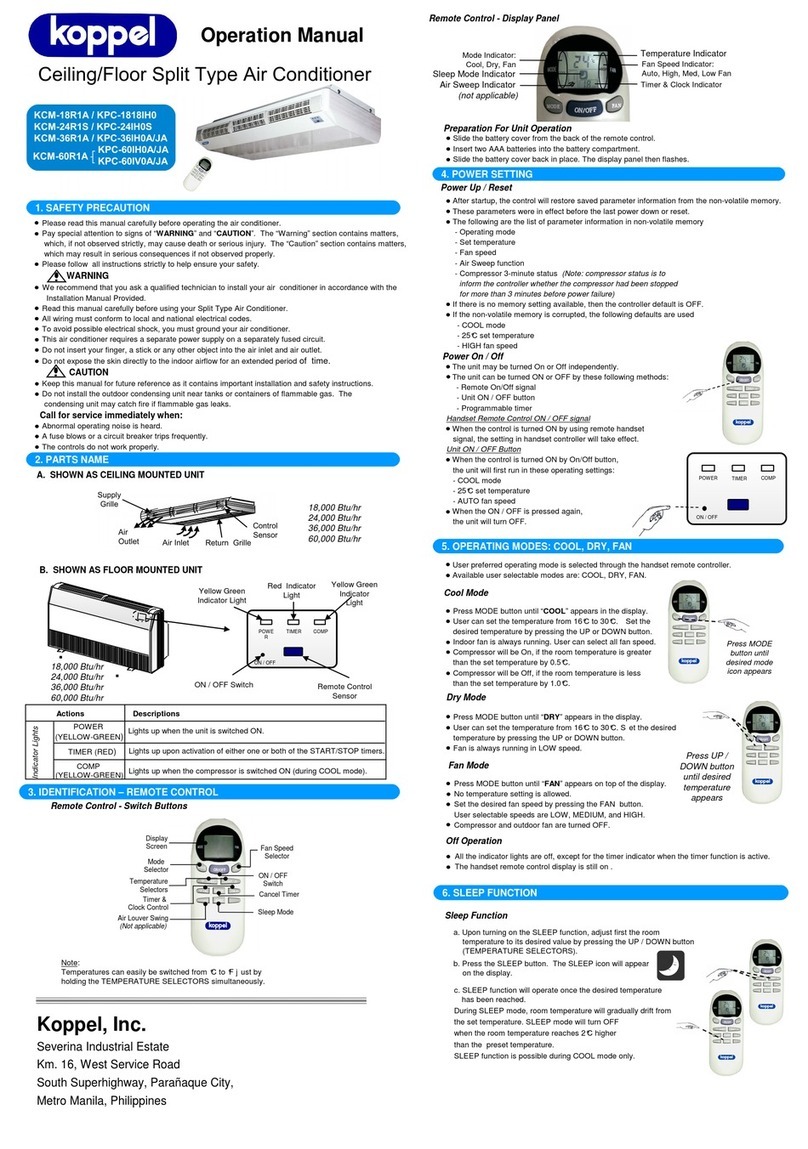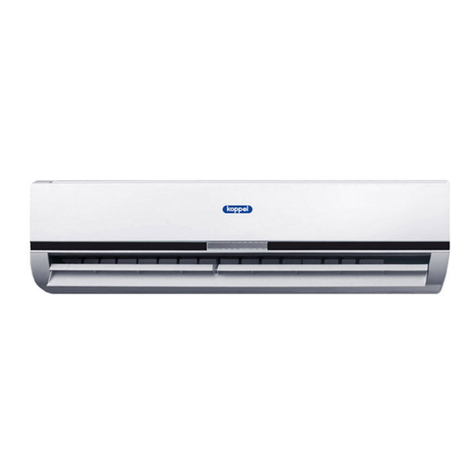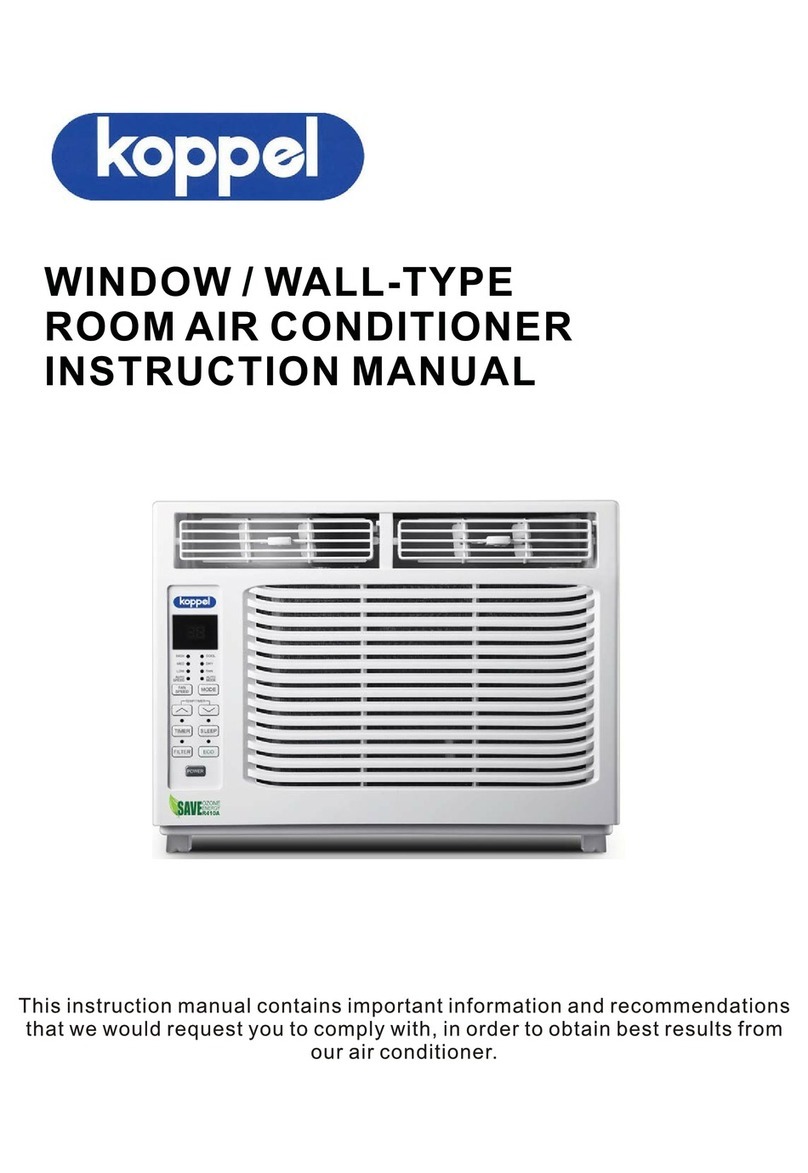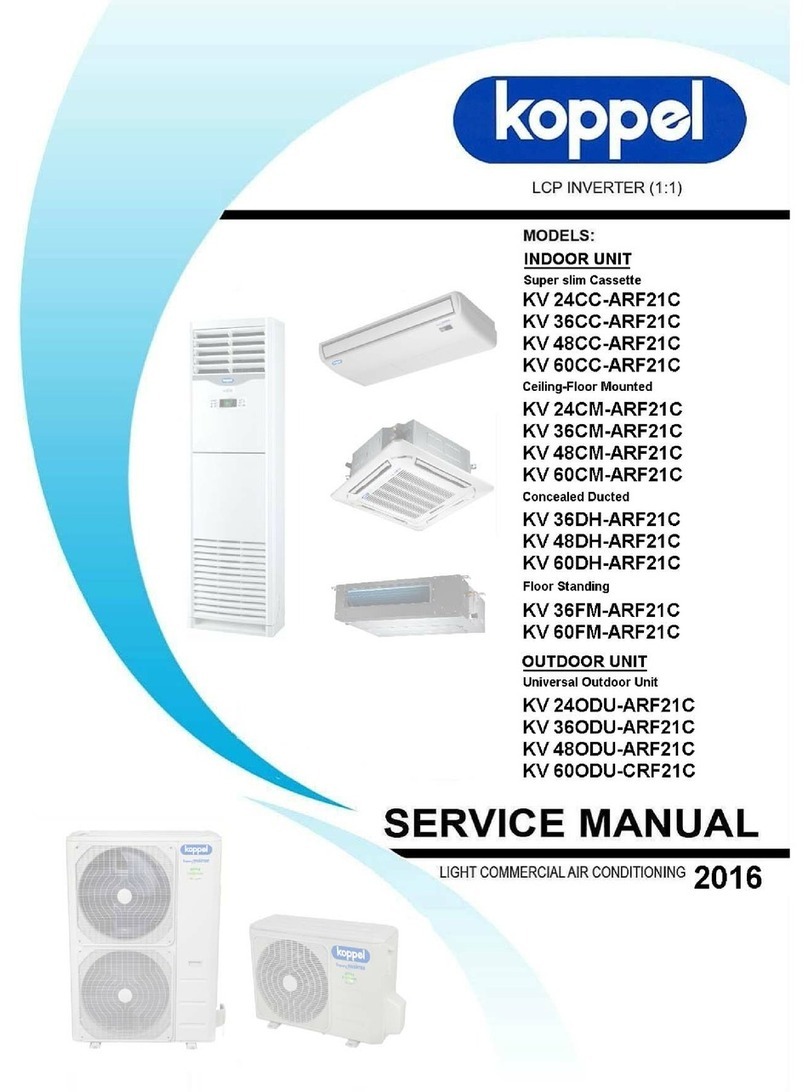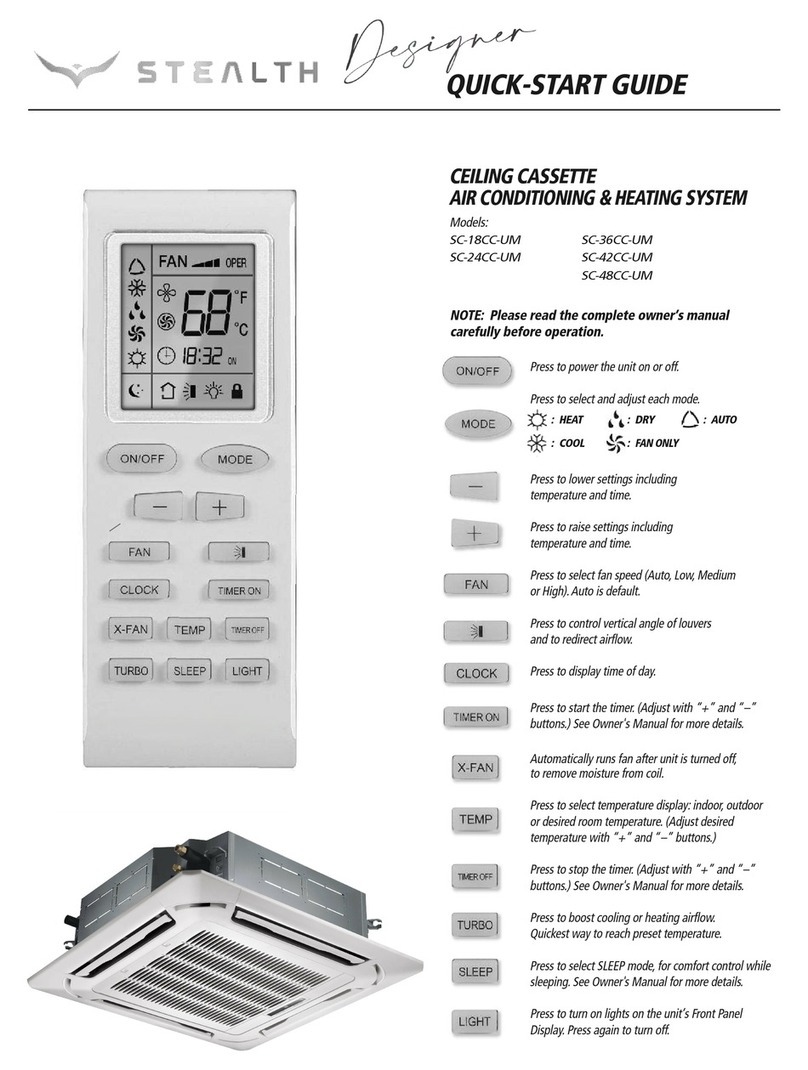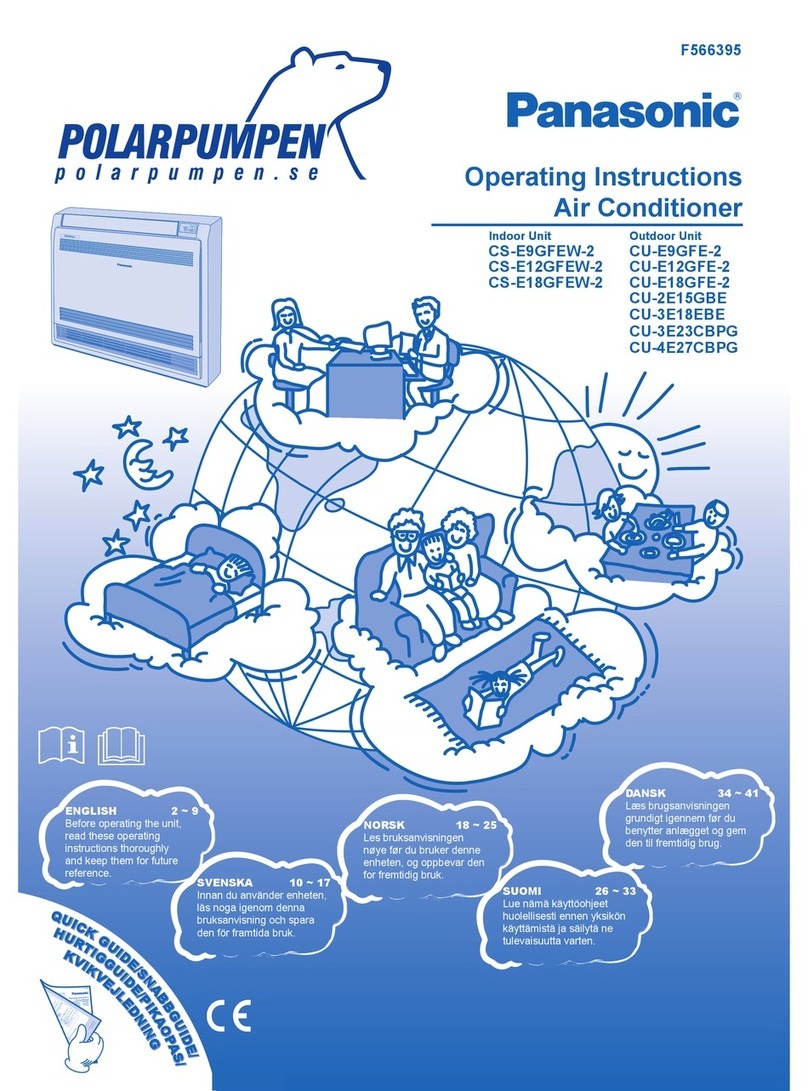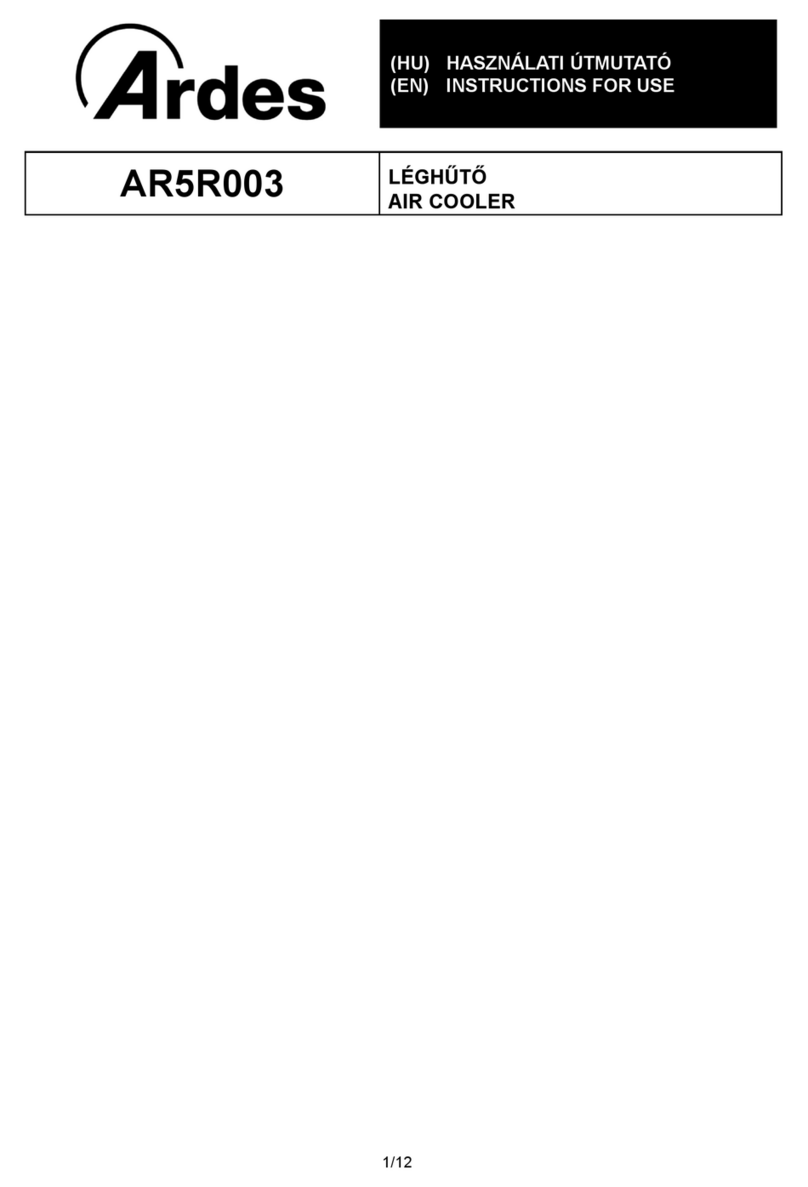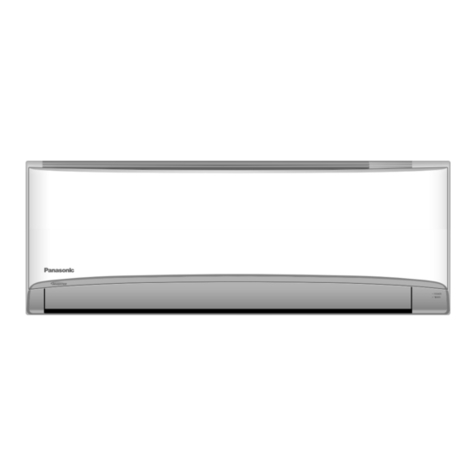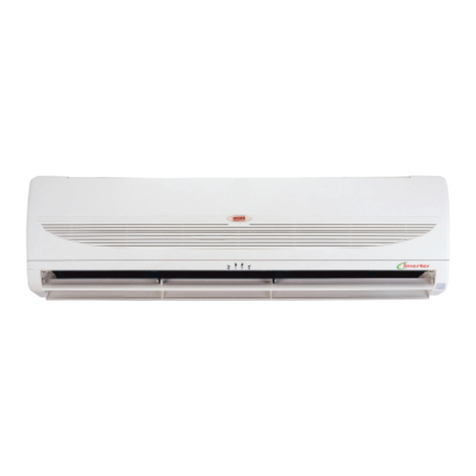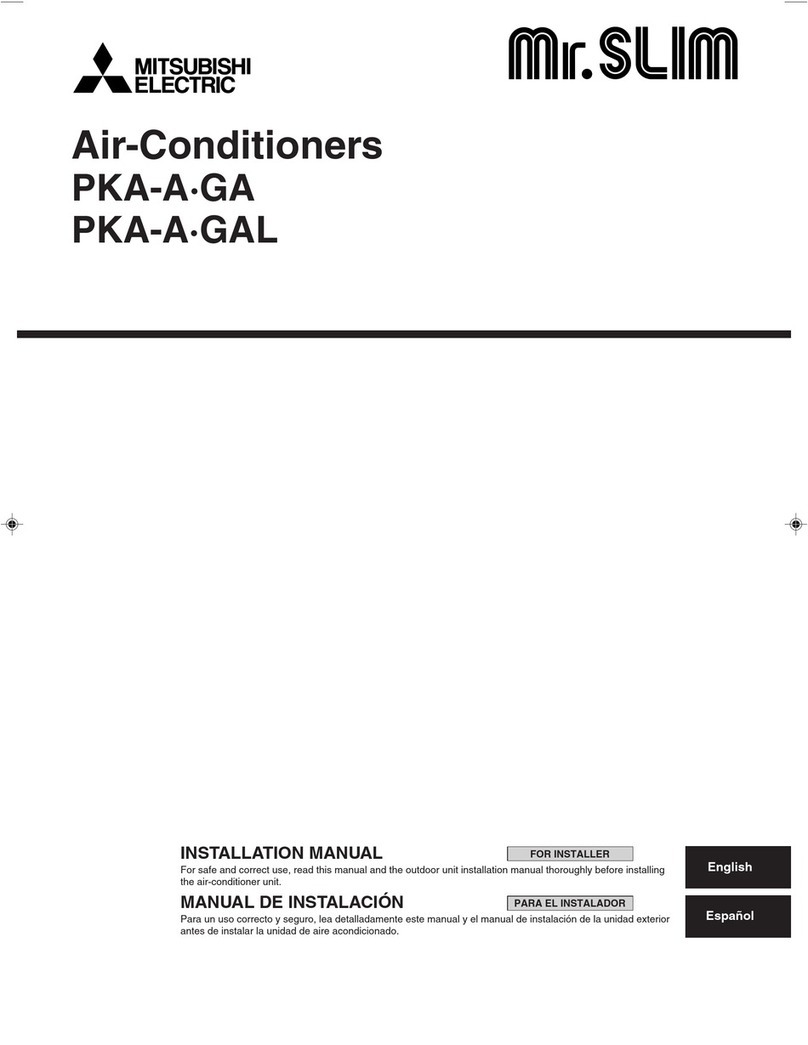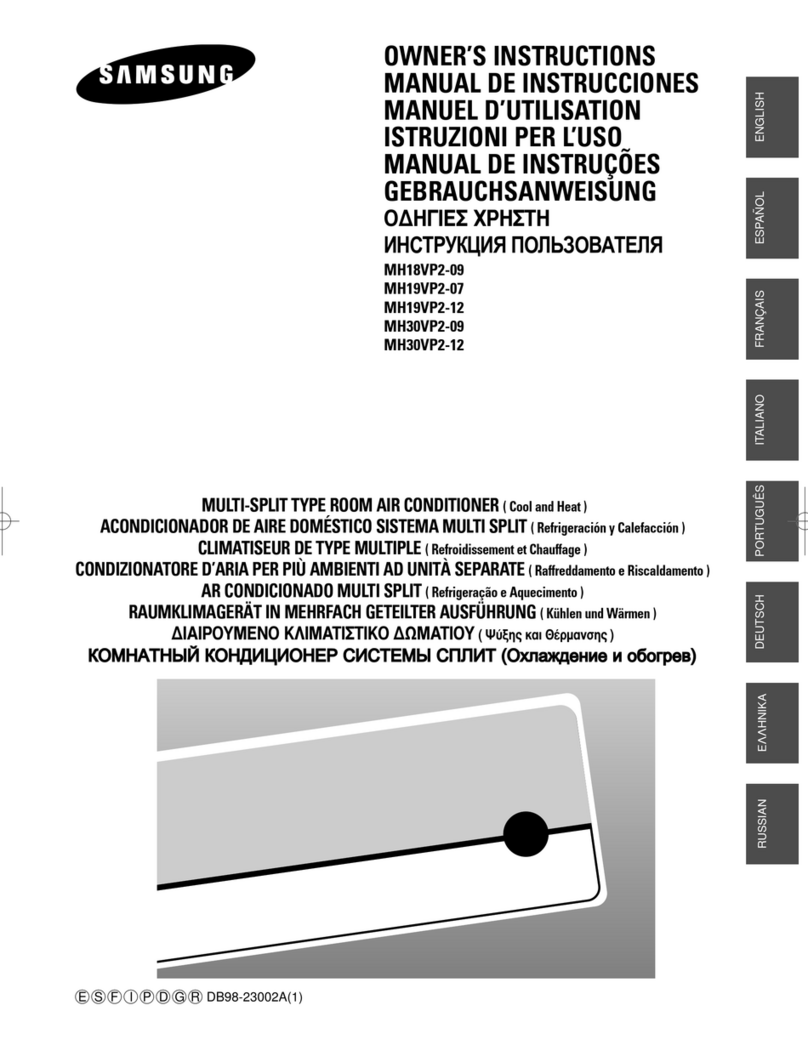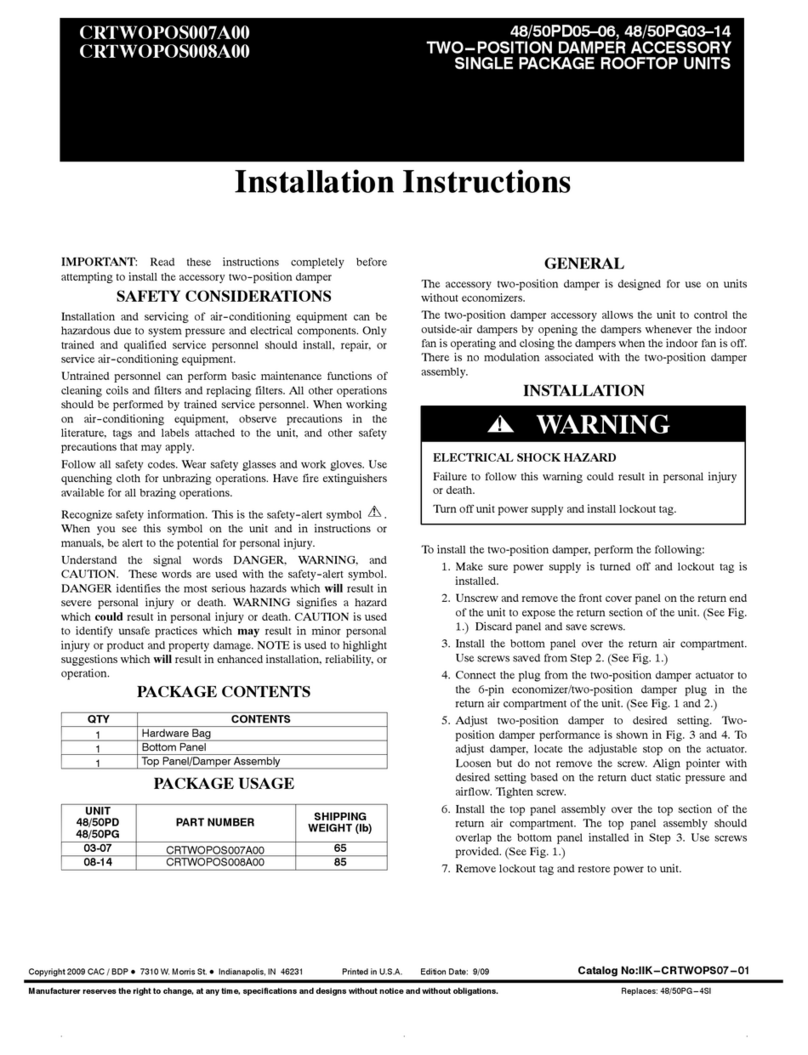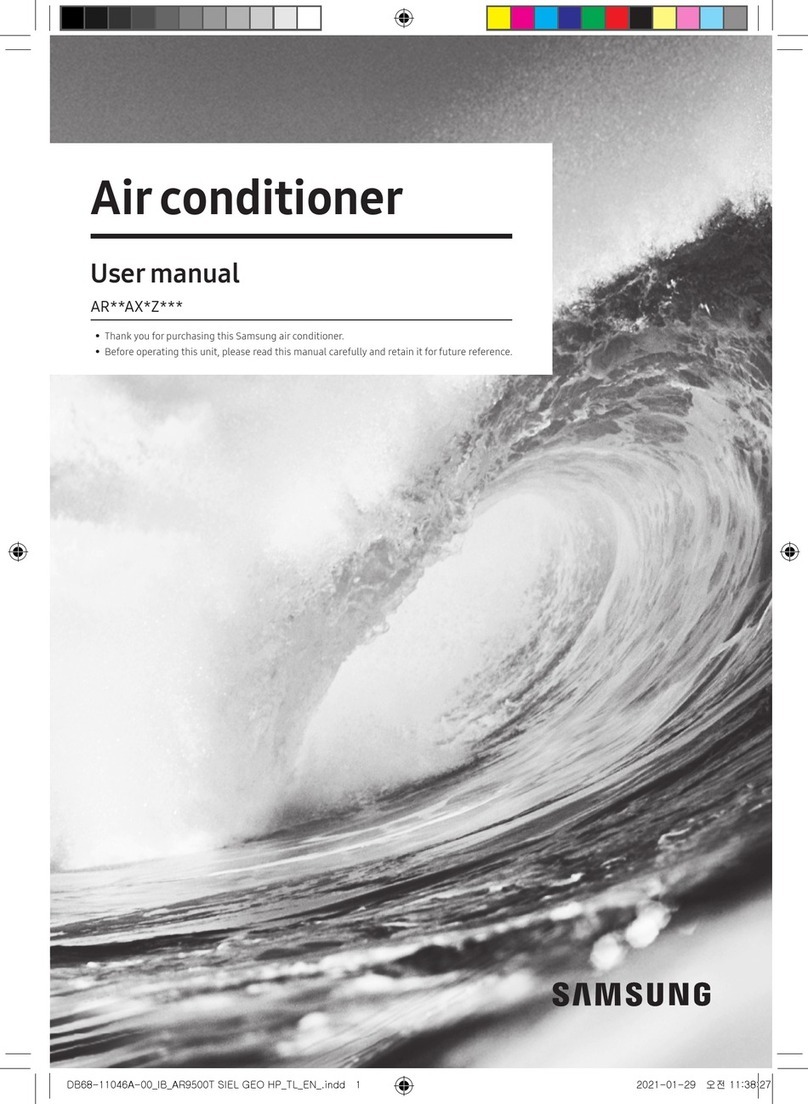koppel KWR-12M4A2 Repair manual

WINDOW TYPE ROOM AIR CONDITIONER
Owner’s Manual & Installation
Owner’s Manual & Installation
Owner’s Manual &
Installation Manual
Before using your air conditioner, please read
th
i
smanual
carefully and keep it for future reference.

Table of Contents
Safety Precautions
.................................................................................03
Unit Parts Identification .............
.............................................................13
Care and Maintenance........................................................................17
Water Drainage ..........................
.............................................................18
Installation Instructions .....................................................................19
Troubleshooting....................................................................................23
Specifications ...............................................................................................25
European Disposal Guidelines
This appliance contains refrigerant and other potentially hazardous materials. When disposing of
this appliance, the law requires special collection and treatment. Do not dispose of this product as
household waste or unsorted municipal waste.
When disposing of this appliance, you have the following options:
•Dispose of the appliance at designated municipal electronic waste collection facility.
•When buying a new appliance, the retailer will take back the old appliance free of charge.
•The manufacturer will take back the old appliance free of charge.
•Sell the appliance to certified scrap metal dealers.
Special notice
Disposing of this appliance in the forest or other natural surroundings endangers your health and is
bad for the environment. Hazardous substances may leak into the ground water and enter the food
chain.
Correct Disposal of This Product
(Waste Electrical & Electronic Equipment)
This marking shown on the product or its literature, indicates that waste electrical and
eletrical equipment should not be mixed with general household waste.

Safety
Precautions
Safety
Read Safety Precautions Before Operation and Installation
The seriousness of potential damage or injuries is classified as either a WARNING or CAUTION.
Incorrect installation due to ignoring instructions can cause serious damage or injury.
WARNING
This appliance can be used by children aged from 8 years and above and persons with reduced
This appliance is not intended for use by persons(including children) with reduced physical, sensory
or mental capabilities, or lack of experience and knowledge, unless they have been given supervision
or instruction concerning use of the appliance by a person responsible for their safety. Children
should be supervised to ensure that they do not play with the appliance.
physical, sensory or mental capabilities or lack of experience and knowledge if they have been given
supervision or instruction concerning use of the appliance in a safe way and understand the hazards
involved. Children shall not play with the appliance. Cleaning and user maintenance shall not be
made by children without supervision(EN Standard requirements).
WARNINGS FOR PRODUCT USE
•
If an abnormal situation arises (like a burning smell), immediately turn off the unit and disconnect
the power. Call your dealer for instructions to avoid electric shock, fire or injury.
•
Do not
insert fingers, rods or other objects into the air inlet or outlet. This may cause injury, since
the fan may be rotating at high speeds.
•
Do not
use flammable sprays such as hair spray, lacquer or paint near the unit. This may cause
fire or combustion.
•
Do not
operate the air conditioner in places near or around combustible gases. Emitted gas may
collect around the unit and cause explosion.
•
Do not
•
•
Do not
expose your body directly to cool air for a prolonged period of time.
•
•
•
•
•
If the air conditioner is used together with burners or other heating devices, thoroughly ventilate
the room to avoid oxygen deficiency.
Safety Precautions
Do not
allow children to play with the air conditioner. Children must be supervised around the
unit at all times.
operate your air conditioner in a wet room such as a bathroom or laundry room. Too
much exposure to water can cause electrical components to short circuit.
In certain functional environments, such as kitchens, server rooms, etc., the use of specially
designed air-conditioning units is highly recommended.
Unplug the unit or disconnect the power supply to the unit if strange sounds, smell, or smoke
comes from it.
To further optimize the performance of your unit, keep doors and windows closed during operation.
Pay attention when unpacking and installing. Sharp edges could cause injury.
Page 3
WARNING
This symbol indicates the possibility
of personnel injury or loss of life.
CAUTION
This symbol indicates the possibility of
property damage or serious consequences.

Safety
Precautions
Page 4
• Do not
clean the air conditioner with combustible cleaning agents. Combustible cleaning agents
can cause fire or deformation.
CLEANING AND MAINTENANCE WARNINGS
•
Turn off the device and disconnect the power before cleaning. Failure to do so can cause
electrical shock.
• Do not
clean the air conditioner with excessive amounts of water.
CAUTION
•
Turn off the air conditioner and disconnect the power if you are not going to use it for a long time.
•
Turn off and unplug the unit during storms.
•
Make sure that water condensation can drain unhindered from the unit.
• Do not
operate the air conditioner with wet hands. This may cause electric shock.
• Do not
use device for any other purpose than its intended use.
• Do not
climb onto or place objects on top of the outdoor unit.
• Do not
allow the air conditioner to operate for long periods of time with doors or windows open,
or if the humidity is very high.
ELECTRICAL WARNINGS
•
Only use the specified power cord. If the power cord is damaged, it must be replaced by the
manufacturer
, its service agent or similarly qualified persons in order to avoid a hazard.
•
Keep power plug clean. Remove any dust or grime that accumulates on or around the plug. Dirty
plugs can cause fire or electric shock.
•
•
•
•
•
•
•
•
•
•
•
•
Do not
pull power cord to unplug unit. Hold the plug firmly and pull it from the outlet. Pulling
directly on the cord can damage it, which can lead to fire or electric shock.
Do not
modify the length of the power supply cord or use an extension cord to power the unit.
Do not
share the electrical outlet with other appliances. Improper or insufficient power supply
can cause fire or electrical shock.Always install circuit breaker and a dedicated power circuit.
Do not use the socket if it is loose or damaged.
Do not place heavy object on the power cord and ensure that the cord is not compressed.
There is danger of fire or electric shock.
If water enters the unit, turn the unit off at the power outlet and switch off the circuit breaker.
Isolate supply by taking the power-plug out or disconnect the power supply to the unit, contact
a qualified service technician.
If connecting power to fixed wiring, an all-pole disconnection device which has at least 3mm
clearances in all poles, and have a leakage current that may exceed 10mA, the residual current
device(RCD) having a rated residual operating current not exceeding 30mA, and disconnection
must be incorporated in the fixed wiring in accordance with the wiring rules.
This unit is earthed through the power cord, make sure that the unit is correctly grounded. The
wall outlet(Air-break switch) should be provided with reliable earth wire.
The unit should be provided with an individual circuit and the circuit breaker/fuse rating should
be the same as that of the power cord and wall outlet. Power cord conductors are distinguished
according to the color as shown in Wiring Diagram located on the top of the machine.
For all electrical work, follow all local and national wiring standards, regulations, and the
Electrical Connection Diagram located on the top panel of the unit.
The product must be properly grounded at the time of installation, or electrical shock may occur.

Safety
Precautions
Page 5
WARNINGS FOR PRODUCT INSTALLATION
1.
Installation must be performed by an authorized dealer or specialist. Defective installation can
cause water leakage, electrical shock, or fire.
2.
Installation must be performed according to the installation instructions. Improper installation
can cause water leakage, electrical shock, or fire.
(In North America,installation must be performed in accordance with the requirement of NEC
and CEC by authorized personnel only.)
3.
Contact an authorized service technician for repair or maintenance of this unit. This appliance
shall be installed in accordance with national wiring regulations.
4.
Only use the included accessories, parts, and specified parts for installation. Using non-standard
parts can cause water leakage, electrical shock, fire, and can cause the unit to fail.
5.
6.
Install the unit in a firm location that can support the unit’s weight. If the chosen location cannot
support the unit’s weight, or the installation is not done properly, the unit may drop and cause
serious injury and damage.
7.
8.
9.
10.
11.
Do not turn on the power until all work has been completed.
When moving or relocating the air conditioner, consult experienced service technicians for
disconnection and reinstallation of the unit.
How to install the appliance to its support, please read the information for details in "Installation
instructions" section .
For units that have an auxiliary electric heater, do not install the unit within 1 meter (3 feet) of
any combustible materials.
Do not
install the unit in a location that may be exposed to combustible gas leaks. If
combustible
gas accumulates around the unit, it may cause fire.
Install drainage piping according to the instructions in this manual. Improper drainage may
cause water damage to your home and property.
TAKE NOTE OF FUSE SPECIFICATIONS
Wall outlet Air-break switch
The air conditioner’s circuit board (PCB) is designed with a fuse to
provide overcurrent protection. The specifications of the fuse are
printed on the circuit board ,such as T3.15A/250V(or 350V), etc,
Note about Fluorinated Gasses
1.
Fluorinated greenhouse gases are contained in hermetically sealed equipment. For specific
information on the type, the amount and the CO2equivalent in tonnes of the fluorinated
greenhouse gas(on some models), please refer to the relevant label on the unit itself.
2.
Installation, service, maintenance and repair of this unit must be performed by a certified
technician.
3.
Product uninstallation and recycling must be performed by a certified technician.

Safety
Precautions
Page 6
WARNING for Using R32/R290 Refrigerant
-Do not use means to accelerate the defrosting process or to clean, other than those
recommended by the manufacturer.
-The appliance shall be stored in a room without continuously operating ignition sources
(for example: open flames, an operating gas appliance) and ignition sourcesor (for example:an
operating electric heater) close to the appliance. The appliance shall be stored in a room
without continuously operating ignition sources (for example: open flames, an operating gas
appliance or an operating electric heater).
-Do not pierce or burn.
-Be aware that the refrigerants may not contain an odour.
-Compliance with national gas regulations shall be observed.
-Keep ventilation openings clear of obstruction.
-The appliance shall be stored so as to prevent mechanical damage from occurring.
-A warning that the appliance shall be stored in a well-ventilated area where the room size
corresponds to the room area as specified for operation.
-Any person who is involved with working on or breaking into a refrigerant circuit should hold
a current valid certificate from an industry-accredited assessment authority, which authorises
their competence to handle refrigerants safely in accordance with an industry recognised
assessment specification.
-Servicing shall only be performed as recommended by the equipment manufacturer.
Maintenance and repair requiring the assistance of other skilled personnel shall be carried
out under the supervision of the person competent in the use of flammable refrigerants.
-Please follow the instruction carefully to handle, install, clear, service the air conditioner to avoid
any damage or hazard. Flammable Refrigerant R32 is used within air conditioner. When
maintaining or disposing the air conditioner, the refrigerant (R32 or R290) shall be recovered
properly, shall not discharge to air directly.
-No any open fire or device like switch which may generate spark/arcing shall be around air
conditioner to avoid causing ignition of the flammable refrigerant used.
Please follow the instruction carefully to store or maintain the air conditioner to prevent
mechanical damage from occurring.
-Flammable refrigerant is used in air conditioner. Please follow the instruction carefully to
avoid any hazard.
Caution: Risk of fire/
flammable materials IMPORTANT NOTE:Read this manual
carefully before installing or operating
your new air conditioning unit.

Explanation of symbols displayed on the unit(For the unit adopts R32/R290
Refrigerant only):
WARNING
This symbol shows that this appliance used a flammable refrigerant. If the
refrigerant is leaked and exposed to an external ignition source, there is a risk of fire.
CAUTION
This symbol shows that the operation manual should be read carefully.
CAUTION
This symbol shows that a service personnel should be handling this
equipment with reference to the installation manual.
CAUTION
This symbol shows that information is available such as the operating
manual or installation manual.
1.Transport of equipment containing flammable refrigerants
See transport regulations
2.Marking of equipment using signs
See local regulations
3.Disposal of equipment using flammable refrigerants
See national regulations.
4.Storage of equipment/appliances
The storage of equipment should be in accordance with the manufacturer's instructions.
5.Storage of packed (unsold) equipment
Storage package protection should be constructed such that mechanical damage to the
equipment inside the package will not cause a leak of the refrigerant charge.
The maximum number of pieces of equipment permitted to be stored together will be
determined by local regulations.
6.Information on servicing
1)Checks to the area
Prior to beginning work on systems containing flammable refrigerants, safety checks are
necessary to ensure that the risk of ignition is minimised. For repair to the refrigerating
system, the following precautions shall be complied with prior to conducting work on the
system.
2)Work procedure
Work shall be undertaken under a controlled procedure so as to minimise the risk of a
flammable gas or vapour being present while the work is being performed.
3)General work area
All maintenance staff and others working in the local area shall be instructed on the nature
of work being carried out. Work in confined spaces shall be avoided. The area around the
workspace shall be sectioned off. Ensure that the conditions within the area have been made
safe by control of flammable material.
4)Checking for presence of refrigerant
The area shall be checked with an appropriate refrigerant detector prior to and during work,
to ensure the technician is aware of potentially flammable atmospheres. Ensure that the leak
detection equipment being used is suitable for use with flammable refrigerants, i.e.
non-sparking, adequately sealed or intrinsically safe.
5)Presence of fire extinguisher
If any hot work is to be conducted on the refrigeration equipment or any associated parts,
Safety
Precautions
Page 7

appropriate fire extinguishing equipment shall be available to hand. Have a dry powder or
CO2 fire extinguisher adjacent to the charging area.
6)No ignition sources
No person carrying out work in relation to a refrigeration system which involves exposing
any pipe work that contains or has contained flammable refrigerant shall use any sources
of ignition in such a manner that it may lead to the risk of fire or explosion. All possible
ignition sources, including cigarette smoking, should be kept sufficiently far away from the
site of installation, repairing, removing and disposal, during which flammable refrigerant
can possibly be released to the surrounding space. Prior to work taking place, the area
around the equipment is to be surveyed to make sure that there are no flammable hazards
or ignition risks. No Smoking signs shall be displayed.
Safety
Precautions
Page 8
7)Ventilated area
Ensure that the area is in the open or that it is adequately ventilated before breaking into the
system or conducting any hot work. A degree of ventilation shall continue during the period
that the work is carried out. The ventilation should safely disperse any released refrigerant
and preferably expel it externally into the atmosphere.
8)Checks to the refrigeration equipment
Where electrical components are being changed, they shall be fit for the purpose and to the
correct specification. At all times the manufacturer's maintenance and service guidelines
shall be followed. If in doubt consult the manufacturer's technical department for assistance.
The following checks shall be applied to installations using flammable refrigerants:
The charge size is in accordance with the room size within which the refrigerant containing
parts are installed;
The ventilation machinery and outlets are operating adequately and are not obstructed;
If an indirect refrigerating circuit is being used, the secondary circuit shall be checked for
the presence of refrigerant;
Marking to the equipment continues to be visible and legible. Markings and signs that are
illegible shall be corrected;
Refrigeration pipe or components are installed in a position where they are unlikely to be
exposed to any substance which may corrode refrigerant containing components, unless
the components are constructed of materials which are inherently resistant to being
corroded or are suitably protected against being so corroded.
9)Checks to electrical devices
Repair and maintenance to electrical components shall include initial safety checks and
component inspection procedures. If a fault exists that could compromise safety, then no
electrical supply shall be connected to the circuit until it is satisfactorily dealt with. If the
fault cannot be corrected immediately but it is necessary to continue operation, an adequate
temporary solution shall be used. This shall be reported to the owner of the equipment so all
parties are advised.
Initial safety checks shall include:
That capacitors are discharged: this shall be done in a safe manner to avoid possibility of
sparking;
That there no live electrical components and wiring are exposed while charging, recovering
or purging the system;
That there is continuity of earth bonding.
7.Repairs to sealed components
1)During repairs to sealed components, all electrical supplies shall be disconnected from the

Safety
Precautions
Page 9
equipment being worked upon prior to any removal of sealed covers, etc. If it isabsolutely
necessary to have an electrical supply to equipment during servicing, then a permanently
operating form of leak detection shall be located at the most critical point to warn of a
potentially hazardous situation.
2)Particular attention shall be paid to the following to ensure that by working on electrical
components, the casing is not altered in such a way that the level of protection is affected.
This shall include damage to cables, excessive number of connections, terminals not made
to original specification, damage to seals, incorrect fitting of glands, etc.
Ensure that apparatus is mounted securely.
Ensure that seals or sealing materials have not degraded such that they no longer serve the
purpose of preventing the ingress of flammable atmospheres. Replacement parts shall be
in accordance with the manufacturer's specifications.
NOTE: The use of silicon sealant may inhibit the effectiveness of some types of leak detection
equipment. Intrinsically safe components do not have to be isolated prior to working on
them.
8.Repair to intrinsically safe components
Do not apply any permanent inductive or capacitance loads to the circuit without ensuring
that this will not exceed the permissible voltage and current permitted for the equipment in
use. Intrinsically safe components are the only types that can be worked on while live in the
presence of a flammable atmosphere. The test apparatus shall be at the correct rating.
Replace components only with parts specified by the manufacturer. Other parts may result in
the ignition of refrigerant in the atmosphere from a leak.
9.Cabling
Check that cabling will not be subject to wear, corrosion, excessive pressure, vibration, sharp
edges or any other adverse environmental effects. The check shall also take into account the
effects of aging or continual vibration from sources such as compressors or fans.
10.Detection of flammable refrigerants
Under no circumstances shall potential sources of ignition be used in the searching for or
detection of refrigerant leaks. A halide torch (or any other detector using a naked flame)
shall not be used.
11.Leak detection methods
The following leak detection methods are deemed acceptable for systems containing
flammable refrigerants. Electronic leak detectors shall be used to detect flammable
refrigerants, but the sensitivity may not be adequate, or may need re-calibration. (Detection
equipment shall be calibrated in a refrigerant-free area.) Ensure that the detector is not a
potential source of ignition and is suitable for the refrigerant used. Leak detection equipment
shall be set at a percentage of the LFL of the refrigerant and shall be calibrated to the
refrigerant employed and the appropriate percentage of gas (25 % maximum) is confirmed.
Leak detection fluids are suitable for use with most refrigerants but the use of detergents
containing chlorine shall be avoided as the chlorine may react with the refrigerant and
corrode the copper pipe-work. If a leak is suspected, all naked flames shall be removed/
extinguished. If a leakage of refrigerant is found which requires brazing, all of the refrigerant
shall be recovered from the system, or isolated (by means of shut off valves) in a part of the
system remote from the leak. Oxygen free nitrogen (OFN) shall then be purged through the
system both before and during the brazing process.

Safety
Precautions
Page 10
12.Removal and evacuation
When breaking into the refrigerant circuit to make repairs or for any other purpose
conventional procedures shall be used. However, it is important that best practice is
followed since flammability is a consideration. Opening of the refrigeration systems shall
not be done by brazing. The following procedure shall be adhered to:
Remove refrigerant;
Purge the circuit with inert gas;
Evacuate;
Purge again with inert gas;
Open the circuit by cutting or brazing.
The refrigerant charge shall be recovered into the correct recovery cylinders. The system shall
be flushed with OFN to render the unit safe. This process may need to be repeated several
times. Compressed air or oxygen shall not be used for this task.
Flushing shall be achieved by breaking the vacuum in the system with OFN and continuing to
fill until the working pressure is achieved, then venting to atmosphere, and finally pulling
down to a vacuum. This process shall be repeated until no refrigerant is within the system.
When the final OFN charge is used, the system shall be vented down to atmospheric pressure
to enable work to take place. This operation is absolutely vital if brazing operations on the
pipe-work are to take place.
Ensure that the outlet for the vacuum pump is not close to any ignition sources and there is
ventilation available.
13.Charging procedures
In addition to conventional charging procedures, the following requirements shall be
followed. Ensure that contamination of different refrigerants does not occur when using
charging equipment. Hoses or lines shall be as short as possible to minimise the amount of
refrigerant contained in them.
Cylinders shall be kept upright.
Ensure that the refrigeration system is earthed prior to charging the system with refrigerant.
Label the system when charging is complete (if not already).
Extreme care shall be taken not to overfill the refrigeration system.
Prior to recharging the system it shall be pressure tested with OFN. The system shall be leak
tested on completion of charging but prior to commissioning. A follow up leak test shall be
carried out prior to leaving the site.
14.Decommissioning
Before carrying out this procedure, it is essential that the technician is completely familiar with
the equipment and all its detail. It is recommended good practice that all refrigerants are
recovered safely. Prior to the task being carried out, an oil and refrigerant sample shall be
taken in case analysis is required prior to re-use of reclaimed refrigerant. It is essential that
electrical power is available before the task is commenced.
a)Become familiar with the equipment and its operation.
b)Isolate system electrically.
c)Before attempting the procedure ensure that:
Mechanical handling equipment is available, if required, for handling refrigerant cylinders;
All personal protective equipment is available and being used correctly;
The recovery process is supervised at all times by a competent person;
Recovery equipment and cylinders conform to the appropriate standards.
d)Pump down refrigerant system, if possible.

Safety
Precautions
Page 11
e)If a vacuum is not possible, make a manifold so that refrigerant can be removed from
various parts of the system.
f)Make sure that cylinder is situated on the scales before recovery takes place.
g)Start the recovery machine and operate in accordance with manufacturer's instructions.
h)Do not overfill cylinders. (No more than 80 % volume liquid charge).
i)Do not exceed the maximum working pressure of the cylinder, even temporarily.
j)When the cylinders have been filled correctly and the process completed, make sure that
the cylinders and the equipment are removed from site promptly and all isolation valves on
the equipment are closed off.
k)Recovered refrigerant shall not be charged into another refrigeration system unless it has
been cleaned and checked.
15.Labelling
Equipment shall be labelled stating that it has been de-commissioned and emptied of
refrigerant. The label shall be dated and signed. Ensure that there are labels on the
equipment stating the equipment contains flammable refrigerant.
16.Recovery
When removing refrigerant from a system, either for servicing or decommissioning, it is
recommended good practice that all refrigerants are removed safely.
When transferring refrigerant into cylinders, ensure that only appropriate refrigerant recovery
cylinders are employed. Ensure that the correct number of cylinders for holding the total
system charge is available. All cylinders to be used are designated for the recovered
refrigerant and labelled for that refrigerant (i.e. special cylinders for the recovery of
refrigerant). Cylinders shall be complete with pressure relief valve and associated shut-off
valves in good working order. Empty recovery cylinders are evacuated and, if possible,
cooled before recovery occurs.
The recovery equipment shall be in good working order with a set of instructions concerning
the equipment that is at hand and shall be suitable for the recovery of flammable refrigerants.
In addition, a set of calibrated weighing scales shall be available and in good working order.
Hoses shall be complete with leak-free disconnect couplings and in good condition. Before
using the recovery machine, check that it is in satisfactory working order, has been properly
maintained and that any associated electrical components are sealed to prevent ignition in
the event of a refrigerant release. Consult manufacturer if in doubt.
The recovered refrigerant shall be returned to the refrigerant supplier in the correct recovery
cylinder, and the relevant Waste Transfer Note arranged. Do not mix refrigerants in recovery
units and especially not in cylinders. If compressors or compressor oils are to be removed,
ensure that they have been evacuated to an acceptable level to make certain that flammable
refrigerant does not remain within the lubricant. The evacuation process shall be carried out
prior to returning the compressor to the suppliers. Only electric heating to the compressor
body shall be employed to accelerate this process. When oil is drained from a system, it shall
be carried out safely.

Operating temperature
When your air conditioner is used outside of the following temperature ranges, certain
safety protection features may activate and cause the unit to disable.
18°C-43°C (64°F-109°F)
18°C-52°C (64°F-126°F)
(For special tropical models)
Cooling operation Outdoor Temperature
Indoor Temperature
To further optimize the performance of your unit, do the following:
• Keep doors and windows closed.
• The capacity of the room air conditioner must fit the room size for efficient and satisfactory
operation.
•
•
•
Do not block air inlets or outlets.
•
Regularly inspect and clean air filters.
If the power supplied to the unit is not plus/minus 10% of the specified rating, the unit
may not function and the fuse may blow.
Noise from the air conditioner will be louder at night than in the daytime. This is because
the noise in the surroundings is comparatively low at night. If your feel that the noise is too
loud, switch the thermostat to lower numbers.
Safety
Precautions
Page 12
When flammable refrigerant are employed, appliance shall be stored in a well -ventilated area
appliances, the nameplate on the unit itself marked the refrigerant charge can be used to calculate
A
min
. Some examples of the results of the calculations according to the formula are given in the
following Tables 1.
min
A = (M/(2,5 x (LFL) x h ))
min (5/4) 02
The required minumum floor area
Ato install an applicance with refrigerant charge
M(kg) shall be in accordance with following:
Table.1
R32
LFL(kg/m )
3Charge Amount in kg
0.306
R290 0.038
0.6
1.0
1.8
2.2
0.6
1.0
1.8
2.2
1.224kg 1.836kg
29
10
3
2
2.448kg
51
19
6
4
3.672kg
116
42
13
9
4.896kg
206
74
23
15
6.12kg
321
116
36
24
7.956kg
0.152kg 0.228kg 0.304kg 0.456kg 0.608kg 0.76kg 0.988kg
543
82 146 328 584 912 1541
30 53 118 210 328 555
9 16 36 65 101 171
6 11 24 43 68 115
196
60
40
Min. Room Area (m )
2
Minimum Room Area ( m )
2
Refrigerant
Type
Installation
Height H0(m)
17°-32°C (62°F-90°F)
where the room size corresponds to the room area as specific for operation.
For factory sealed

Page 13
UNIT PARTS IDENTIFICATION
Unit Parts
Identification
NOTE: Different models have different front panels and cabinets.
Illustrations in this manual are for
explanatory purposes. The actual shape of your indoor unit may be slightly different. The actual
shape shall prevail. See the following figures for references:
1
1. Front panel
2. Air filter
3. Frame
4. Cabinet
Seal( )
(Used on
drain joint)
Drain Joint( )
[ ] Model dependent
1 pc 1 pc 1 pc 1 pc 4 pcs
CLOSE VENT OPEN CLOSE OPEN
1~2 pc
(depending on
models)
2 pcs(For some units, used)
to fasten the front panel)
2 pcs or 4 pcs(used to install
the drain pan)
Drain pan( )
or
Rubber Plug Screw PVC sheath and
cable ties( )
Accessories
234
5
6
7
8
9
12
34
5
6
7
8
5. Air inlet grille(outdoor side)
6. Air outlet grille
7. Operation knob
8. Power supply cord
9. Control panel cover(some units)
Vent Control
The vent control is located above the control knobs. The operation method and the shape may vary
in different models (see the following figures)
For maximum cooling efficiency, CLOSE the vent. It will allow internal air circulation. OPEN the vent to
discharge stale air.
NOTE: The vent control is not available for all the units. Some units do not have vent control.



Page 16
Manual control lever
Air direction control
Operation panel cover (some units)
Horizontal airflow adjustment
For the units with AUTO SWING switch
(Automatically)
For the units with operation panel cover
(see the left figures of A & B)
For the units with manual control lever(Manually)
A
Fig. C
Fig. D
Fig. E
Fig. F
B
OFF ON
AUTO SWING
Vertical airflow adjustment(Manually)
When the AUTO SWING switch is turned to “ON” position,
the horizontal airflow louvers oscillate right and left sweeping
the cold air alternately to obtain comfortable cooling.
The louvers may be stopped at any position when the
AUTO SWING switch is turned to “OFF” position(see Fig.C).
1. Grasp the top or the left of the operation cover
and pull it to open it.
2. Close the operation cover and press the cover
again until it snaps into the locked position.
DO NOT press or swing the opened operation cover.
To adjust horizontal airflow direction, move the lever gently
to the left or right by hand until the desired horizontal
airflow direction is obtained(see Fig.D).
When the unit is operating, use the hand to adjust the
louvers to change the vertical airflow direction.
The vertical angle of air flow can be set by gripping the
louver and move to the desired position(see Fig.E).
For some units, the connecting rod of the louver is
provided with a convex block , it can be moved between
the three grooves on the left side of frame at an angle of
0-15 degrees(see Fig.F).
Unit Parts
Identification
Grooves
Convex block

Page 17
Cleaning Your Unit
BEFORE CLEANING OR
MAINTENANCE
ALWAYS TURN OFF YOUR AIR CONDITIONER
SYSTEM AND DISCONNECT ITS POWER SUPPLY
BEFORE CLEANING OR MAINTENANCE.
CAUTION
The cabinet and front panel may be dusted with
an oil-free cloth or washed with a cloth dampened
in a solution of warm water and mild liquid
dishwashing detergent. Rinse thoroughly and
wipe dry.
•
Do not use inflammable sprays such as lacquer
or hair spray near the air conditioner
•
Do not use benzene, alcohol, gasoline, acid,
paint thinner, polishing powder or other
solvents to clean the unit. The unit can be
damaged.
•
•
Do not use water hotter than 50°C (122°F)
to clean the front panel. This can cause the
panel to deform or become discolored.
Excess water in or around the controls may
cause damage to the air condtioner. Be sure to
wring excess water from the cloth before
wipe it clean.
Cleaning Your Air Filter
A clogged air filter can reduce the cooling
efficiency of your unit and increase operating noise.
Make sure to clean the filter once every two weeks
(or as necessary) during periods of frequent
operation.
1.
Hold the slot under the front panel, then uplift
it outwards, and remove the front panel.
Pinch the handle under the air filter and make
the air filter arched, remove it from the slot
from underside to upside(Model A).
Grasp the handle of the filter, then slide it
downwards to remove the filter(Model B).
Clean the filter with warm, soapy water. The
water should be below
40°C (104°F) to
prevent
distortion of the filter.
2.
3.
CARE AND MAINTENANCE
4.
5.
6.
If your filter has a small air freshening filter,
clean this air freshening filter with a hand-held
vacuum.
Rinse the air filter with fresh water, then shake
off excess water.
Dry it in a cool, dry place, and refrain from
exposing it to direct sunlight.
Winter Storage
CAUTION
NEVER operate the air conditioner without
the air filter, as dust/dirt particles can
contribute to equipment failure.
Care and
Maintenance
Model A
If your filter has a small air
air freshening filter(optional) ,
it can be installed at any of
the four positions, install it
at the postion as you like .
Clean it with a hand-held
vacuum.
Model B
1
2
3
4
If you plan to store the air conditioner during the
winter, remove it carefully from the window
according to the installation instructions. Cover
it with plastic or return it to the original carton.

WATER DRAINAGE
Page 18
Note on the product
Water
Drainage
•
•
The condensed water can be treated as follows:
Bottom drainage (Applicable for the units designed
with bottom drain hole only. )
- Remove the rubber plug from the bottom of cabinet(if any)
- Take out the drain pan and screws from accessary.
- Fix the drain pan onto the bottom of cabinet by screws.
- Connect an extension drain hose (locally purchased) to
the outlet of drain tray.
NOTE: The bottom drainage will slightly affect cooling
performance, but it can reduce the noise caused by
spraying the condensed water. For pump heating, the
bottom drainage must be choosed.
Back drainage
- Fit the seal onto the drain joint(provided as accessory).
- Insert the drain joint to the back drainage hole, and
rotate it by 90° to be well fitted.
- Connect an extension drain hose (locally purchased
according to the installation length request) to
the drain joint.
- Make sure to plug the bottom drain hole by rubble plug.
NOTE: The back drainage will slightly affect cooling
performance, but will reduce the noise caused by
spraying the condensed water.
Non-drainage
If you choose non-drainage when cooling, both the
bottom and the back drain holes of the unit should be
plugged with rubber plugs.
The condensed water will be sprayed to condenser, and
will improve the cooling performance.
NOTE:
When you choose non-drainage, the air conditioner will
be perfect cooling efficiency, but big noise may be caused
by spraying the condensed water. Please do not choose it
if you are sensitive to the noise.
The rated cooling performance is tested under
non-drainage status.
Make sure that water will not leak from the
surrounding area when rubber plug and joint were
used. Please seal it in case leakage is found.
Back drain
hole
Back drain
hole
Drain
joint Seal
Rubber
plug
Screw
Drain pan
Drain
outlet
Rubber
plug
Rubber
plug
Bottom drain
hole
Bottom drain
hole
Bottom drainage
Back drainage
Non-drainage

Step 1: Select the best location
Step 2: Remove the front panel and air
filter
Prior to installation
INSTALLATION INSTRUCTIONS
Page 19
Remove inserts placed
into the side louvers
300mm or more
80mm or
more
45 brick cut away
to clear louvers
Awning
Fence
Option A
Option B
Front
Outdoor
side
Indoor
side
Wall
75~150cm
500mm or more
Level
Unit
About 5~7mm
CAUTION: Before installing, remove all packaging
from inside the carton, along with any
inserts placed into the side louvers.
CAUTION
All side louvers of the cabinet must remain
exposed to the outside of the structure
Installation
Instructions
1. To avoid vibration and noise, make sure the unit
is installed securely and firmly.
2. Install the unit where the sunlight does not shine
directly on the unit. If the unit receives direct
sunlight, build an awning to shade the cabinet.
3. There should be no obstacle, such as a fence or
wall, within 50cm from the back of the cabinet
because it will prevent heat radiation of the
condenser. Restriction of outside air will greatly
reduce the cooling and heating efficiency of the
air conditioner.
4. Install the unit a little obliquely downward to
outside not to leak the condensed water into
the room (about 5~7mm).
5. Install the unit with its bottom portion 75~150cm
above the floor level.
6. The power cord must be connected to an
independent circuit. The yellow/green wire must
be grounded.
1. Take out the air conditioner from it’s packaging.
2. Hold the slot under the front panel, then uplift it
outwards, and remove the front panel( See Fig. 1)
3. Grip the tab on the end of the filter, lift it up, then
pull it towards yourself, pull the filter out(see Fig.2)
O
45 brick cut away
to clear louvers
O
Air in
Air in
Air in
Air out
100mm Min.
500mm Min.
Brick
wall Brick
wall
Air in
100mm
Air out
100mm
Air in
Louver
Top View

Step 3: Remove the frame
Page 20
Installation
Instructions
NOTE: There are slight differences on removing
the frame according to the different models.
Model A:
1. Remove one screw securing the chassis fixing
bracket, then take down the chassis fixing
bracket as shown in Fig.3A.
2. Hold the left bottom side of the frame, lift it
up to unlatch the lower side, remove it toward
you.(see Fig.4)
Model B:
1. Remove one screw securing the chassis fixing
bracket, then take down the chassis fixing
bracket. Remove two screws located on the
back of the cabinet as shown in Fig.3B.
2. Hold the left bottom side of the frame, lift it
up to unlatch the lower side, remove it toward
you.(see Fig.4)
Model C:
1. Remove four screws located on both sides and
the back of the cabinet as shown in Fig.3C.
2. Hold the left bottom side of the frame, lift it
up to unlatch the lower side, remove it toward
you.(see Fig.4)
Model D:
1. Remove one screw securing the chassis fixing
bracket, then take down the chassis fixing
bracket.(see Fig.3D)
2. Remove four screws located on both sides and
the back of the cabinet as shown in Fig.3D.
3. Hold the left bottom side of the frame, lift it
up to unlatch the lower side, remove it toward
you.(see Fig.4)
Fig.3A
Fig.3B
Fig.3C
Fig.3D
Fig.4
Table of contents
Other koppel Air Conditioner manuals

koppel
koppel 12 User manual

koppel
koppel KPC-18H5 User manual
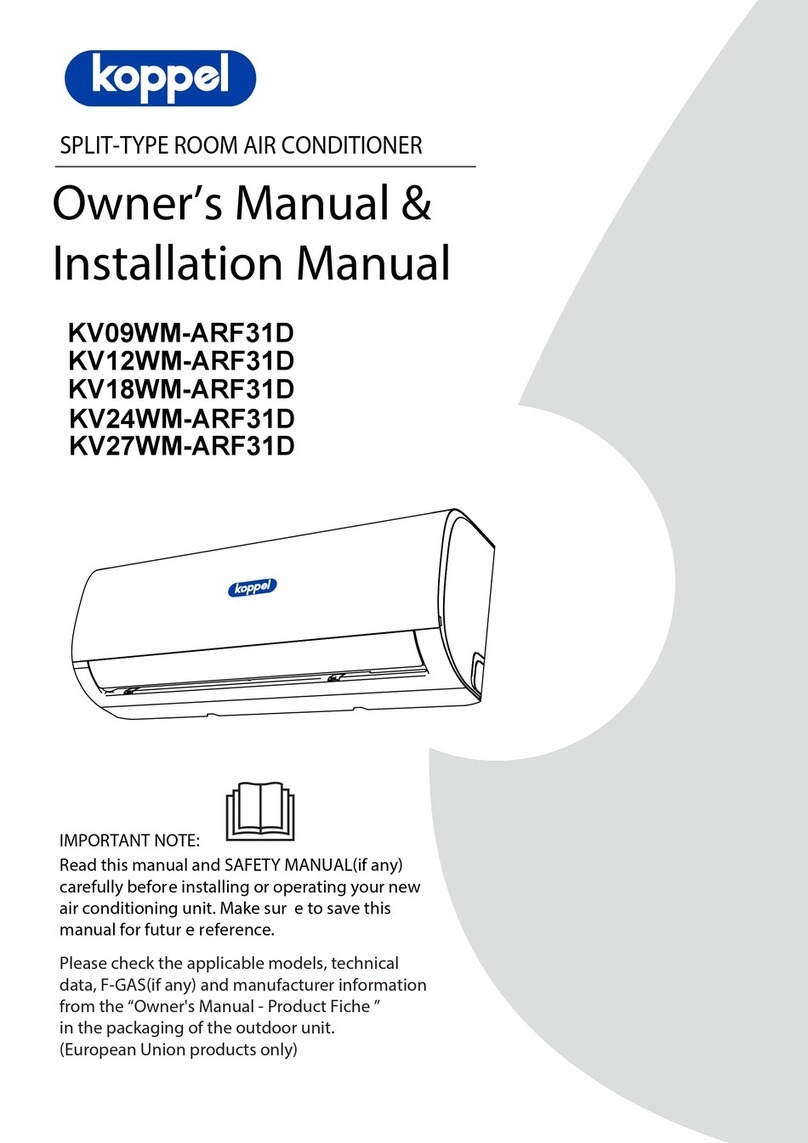
koppel
koppel KV09WM-ARF31D Repair manual
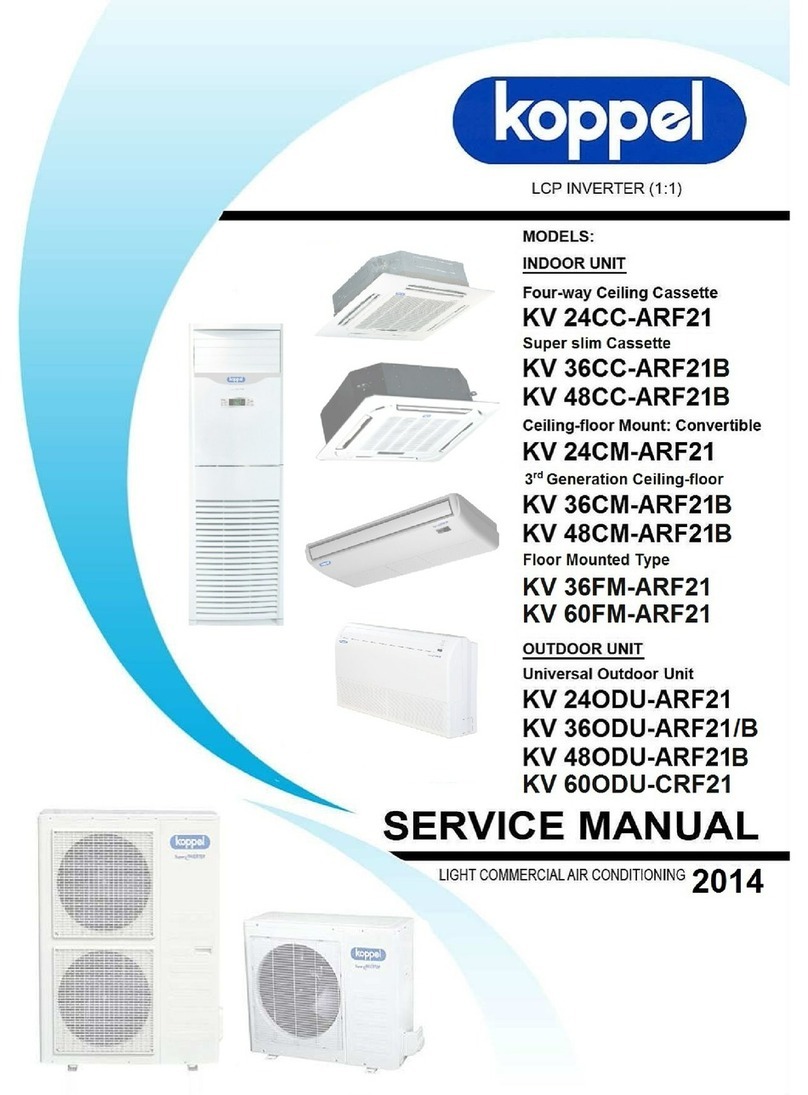
koppel
koppel KV 24CC-ARF21 User manual
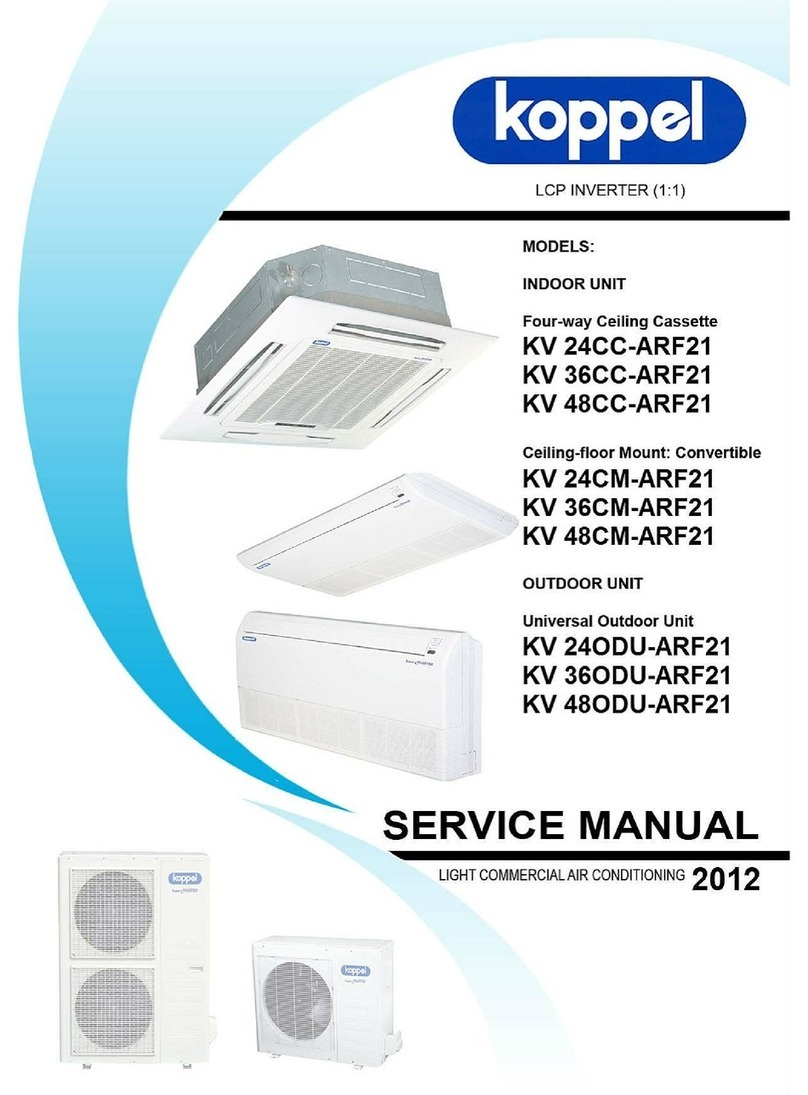
koppel
koppel KV24ODU-ARF21 User manual

koppel
koppel ERA series User manual
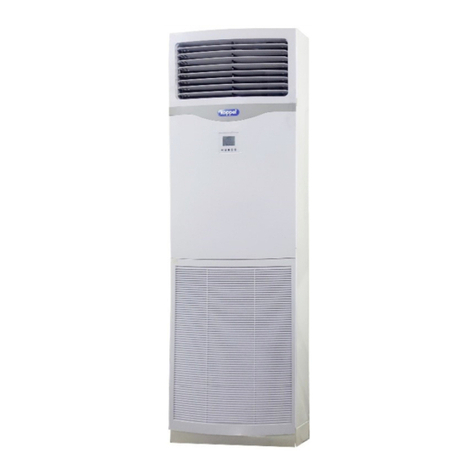
koppel
koppel KFM-36E0C User manual
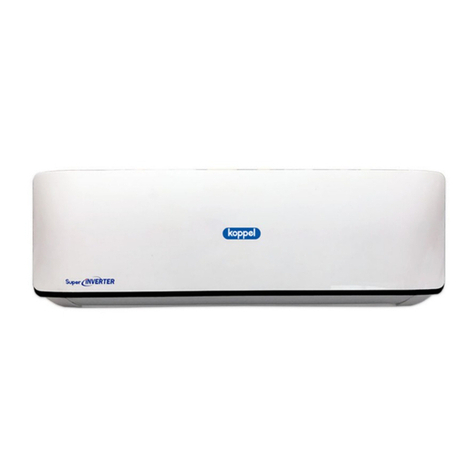
koppel
koppel KV09WM-ARF21B User manual

koppel
koppel KCA-60R1 User manual

koppel
koppel CASSETTE-TYPE AIR CONDITIONER User manual
